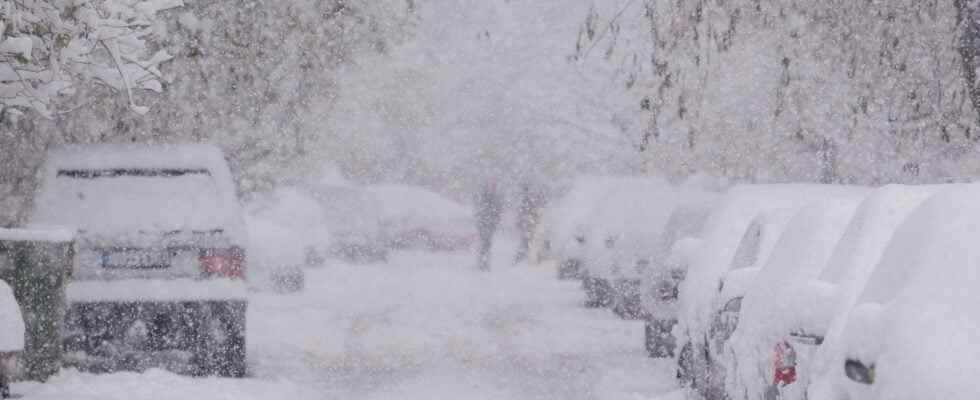A very common phenomenon in summer, thunderstorms can also occur in the middle of winter. Snow storms are rare, but always impressive, and form in very specific weather situations. Certain geographic areas are more conducive to their observation than others.
You will also be interested
[EN VIDÉO] How do thunderstorms form? France has an average of 250 days of thunderstorms per year. How and why are these powerful phenomena born, accompanied by lightning and thunder?
A snowstorm refers to the fact that a cumulonimbus, storm cloud, spills precipitation snowy in the plains, accompanied bylightning. The formation of thunderstorms snowfall is quite similar to that of classic spring and summer thunderstorms.
Two necessary weather ingredients
The snow storm formation requires two ingredients weather report : a soft and humid air mass in the lower layers of theatmosphere and an influx of very cold air at altitude. The presence of these two elements generates a conflict of air masses, therefore instability. The air mass must be very cold, of polar origin or Arctic, with a flow coming from the north-west or the north-east over France. But in addition to this “cold drop”, humidity must also be very present at ground level: this weather configuration is mainly present near the coast.
The snowstorm has several peculiarities that differentiate it from thethunderstorm spring and summer: first of all, the cloud storm is not very high: 4 to 7 kilometers above sea level, unlike summer storms which peak between 10 and 15 kilometers on average. It is precisely because these cloudy peaks are not very high in winter, that thunderstorms rarely form at this time of the year, unlike in the summer when the heat allows the cloud to rise very high and then generate a violent thunderstorm. The snowstorm is also very ephemeral and much less violent than in summer with only one to two Thunder, rarely more. It is difficult to spot it because the noise of the thunder is less noticeable, we hear it less because the sound is muffled by the snowfall. While the thunder of summer thunderstorms can be heard up to 20 kilometers away, the thunder of snow thunderstorms is only audible, in the best case, at 3 or 4 kilometers away.
Observers fortunate enough to see lightning through the snow describe flashes purple or dark blue, one color darker than that of summer due to “mixing” with the white color of snow.
Where can we see snow storms?
You must know that their prediction is difficult, if not almost impossible at present, even for the best meteorologists. According to British Royal Meteorological Society, 0.07% of snowfall is linked to a snowstorm in the United States, a country where it is however most often observed! It is in the Great Lakes region, United States or Canada side, that most snow storms occur, because all the conditions are met: extreme cold from the Arctic and humidity from gigantic lakes. Snow storms erupt there when the “lake effect” occurs: freezing air takes on moisture as it hovers over the vast bodies of water of the Great Lakes. Storm clouds form by condensation and dump phenomenal amounts of snow on the land nearby, as happens almost every year in New York State.
In the rest of the world, snow storms are occasionally observed over the British Isles (Scotland in particular), the Sea of Japan coasts, Israel, Jordan, Brazil and the Himalayas.
In France, snow storms are infrequent, but not impossible. We can sometimes see it in the north and north-west of France: in Normandy, or in the Nord-Pas-de-Calais (and very rarely in the North-East and the South-East). The North-West is indeed sometimes affected by polar air flows, and the presence of the Channel Sea nearby brings humidity.
Snow storms are twice as dangerous
Even if they are much less violent than those of the summer as regards the lightning, snow storms remain dangerous. In the United States, residents of the Northeast, more accustomed to this risk, usually say that snowstorms are “twice as dangerous” because they combine the dangers of a thunderstorm, in addition to the dangers of snowstorms. ‘a snow storm. Snowfall is often very heavy under the storm (10 centimeters per hour under American snow storms), suddenly, and can surprise on the road. Under such heavy snowfall, visibility is reduced to zero in a few moments, risking piling up. As in summer thunderstorms, the wind can also be very powerful in a thunderstorm, and cause falls oftrees (with branches weighed down by snow) and electric cables. The sound of thunder muffled by snow is also an aggravating factor: a person walking under snow does not realize they are under a thunderstorm and therefore risks being struck by lightning.
Snow storm in Boston. © The Weather Channel, YouTube
The surprise of being confronted with this very rare phenomenon should therefore not make us forget the classic safety instructions in the event of a thunderstorm, and in the event of a snowstorm.
Interested in what you just read?
.
fs12
